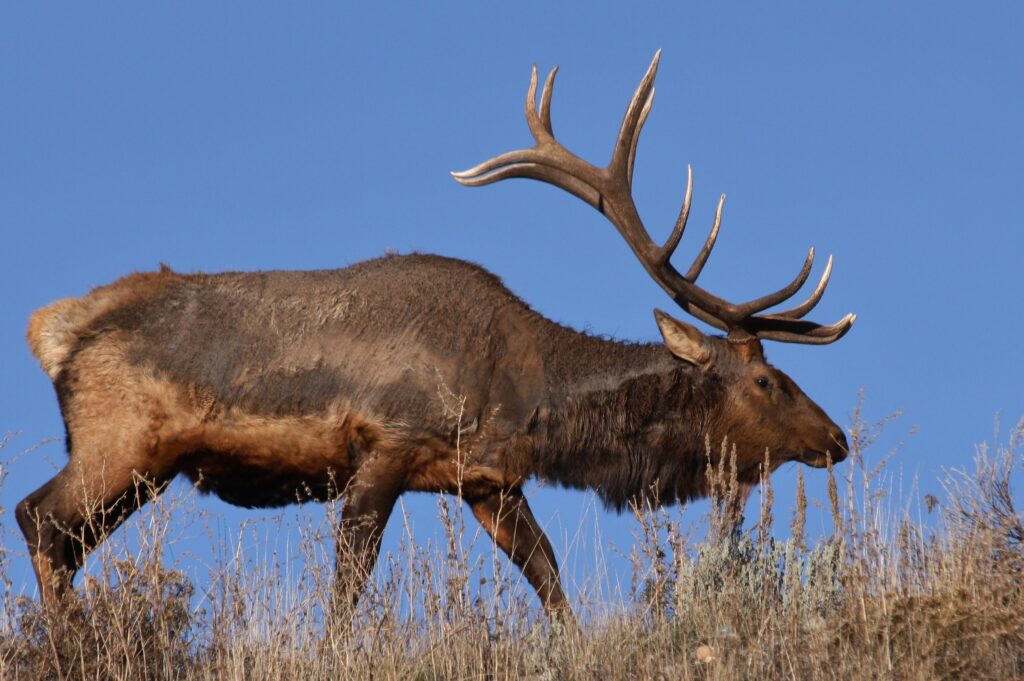Visiting Grand Teton National Park in September and October provides an incredible opportunity to witness the elk mating season, aka the rut, hear the eerie sound of bugling, and see bull elk with impressive antlers go head to head (literally).
The bulk of the elk rut in the Tetons runs from late August/early September through mid-October. Elk begin to form mixed herds, called harems, of cows, calves, and a few bulls. Typically, each harem has one herd bull, but there may be a few yearling bulls (called “spike bulls”) in the group. These yearling bulls pose no threat to the herd bull. Satellite bulls on the outside of the harem are often looking to pull away females from the harem in order to breed with them – the herd bull works very hard to prevent this from happening.
If a herd bull notices that a cow begins to stray, he may attempt to keep her close by circling her while “stretching his neck out low, tipping up his nose, and tilting his antlers back” (Rocky Mountain Elk Foundation). While it may seem counterintuitive to humans, one way bull elk attempt to attract cows is by wallowing and coating themselves in mud and their own urine. They also signal their fitness and availability to cow elk by bugling, which the Rocky Mountain Elk Foundation describes as a “bellow escalating to [a] squealing whistle ending with [a] grunt.” Bulls guard their harems from each other and will battle for dominance. Bugling can act as a challenge from one bull to another and lead to a battle, with each bull using his antlers to push the other. The battle ends when the weaker bull gives up.
Some of the best places to hear bugling in Grand Teton National Park are:
- The Bradley-Taggart parking area and trailhead, or Cottonwood Creek Road (branches off the main park road on the east side, just past the Bradley-Taggart parking area).
- White Grass Meadow (off of Death Canyon Road)
- The meadows around the Granite Canyon parking area
- Cattleman’s Bridge Road, just west of Oxbow Bend on the north side of the park. From the parking area at the end of this road, you can sometimes hear elk bugles echo across the Snake River.
Aside from bugling and growing herds, large antlers may be the most noticeable sign of the approaching elk rut. At around one year old, bull elk begin growing their first set of antlers. New antler growth begins in the spring. At this time, antlers are covered in a fuzzy skin called velvet. Antlers grow because velvet is alive, and contains blood vessels that deposit the calcium that builds each antler. This growth is incredibly fast – up to one inch per day, making antlers one of the fastest growing animal tissues on earth (USFWS). Antler growth usually stops in early August, when additional hormones trigger bull elk to begin rubbing the velvet off on tree trunks or shrubs, revealing the solid bone underneath. Elk antlers can weigh up to 20 pounds and grow to 4 feet long and wide (USFWS).
So, why do bull elk invest so much energy into growing antlers every year? One reason is social structure: larger antlers that are retained longer push bull elk to the top of the social structure, and give them better access to grazing areas and mates. Per the US Fish and Wildlife Service, “antler size is an indication of male health because antlers take a considerable amount of resources to produce and carry. Only healthy males can produce the largest antlers.” Additionally, retaining antlers through the winter allows bulls to settle disputes with their antlers (by colliding and pushing) rather than their hooves, which reduces serious injuries. In the late winter and early spring, lengthening daylight and lower testosterone levels in March and April trigger bull elk to shed the previous year’s antlers. Antlers grow from pedicles, bony protrusions in the elk’s skull – when a set of antlers is shed, the pedicles are often injured. One to two weeks later, when the pedicles have healed, a new set of antlers begins to grow (USFWS).
Book a tour with Wildlife Expeditions of Teton Science School this September for the experience of a lifetime – see the elk rut in Grand Teton National Park up close and with a professional guide! We can’t wait to share the magic of this amazing ecosystem with you.
*Much of the information in this blog comes directly from the National Park Service’s 2024 Yellowstone Resources and Issues Handbook.
Sources:
- https://rmef.org/elk-facts/
- https://www.google.com/url?q=https://www.gtnpf.org/adventure-journal-top-3-spots-to-listen-to-elk-bugle-in-october/&sa=D&source=docs&ust=1724104553030041&usg=AOvVaw2d20frTKOkiwetsa-7PWrN
- https://www.gtnpf.org/adventure-journal-top-3-spots-to-listen-to-elk-bugle-in-october/
https://www.nps.gov/yell/learn/upload/8_RI_2024_Wildlife.pdf


